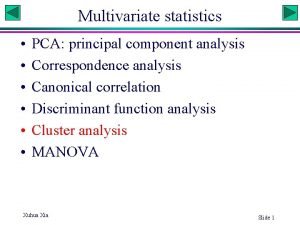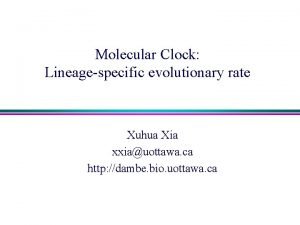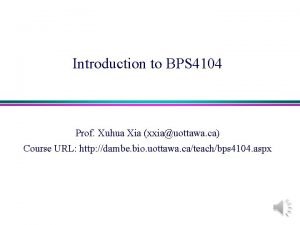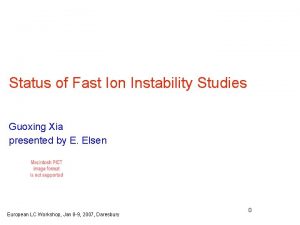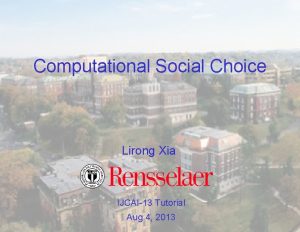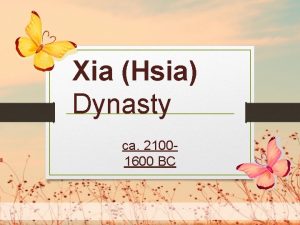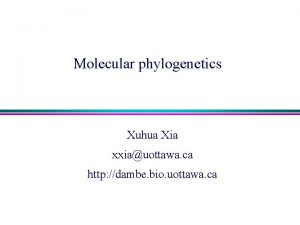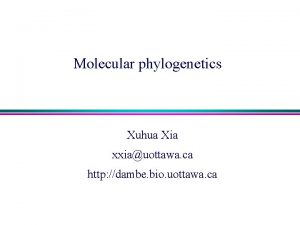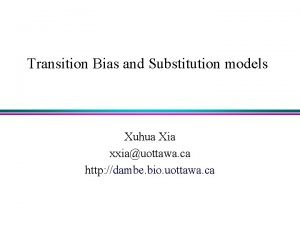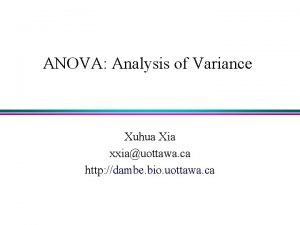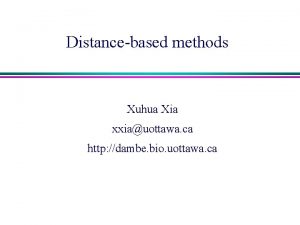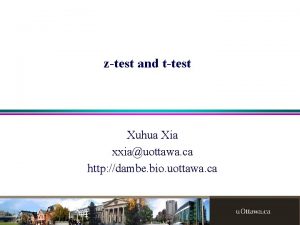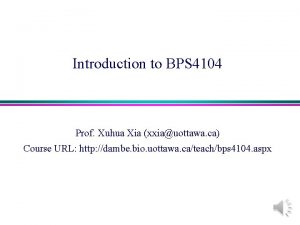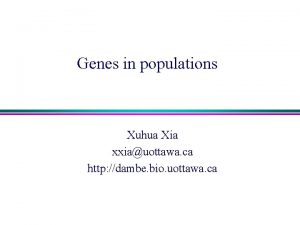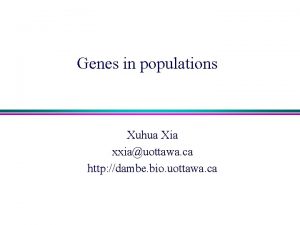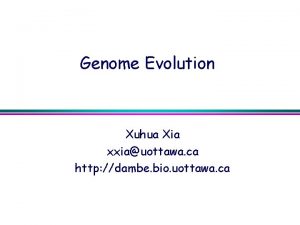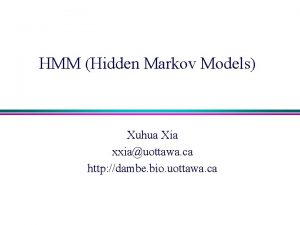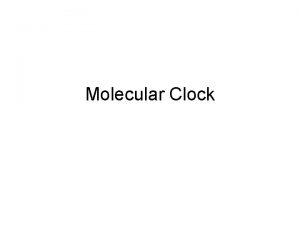Molecular Clock An Interesting Application Xuhua Xia xxiauottawa






















- Slides: 22

Molecular Clock: An Interesting Application Xuhua Xia xxia@uottawa. ca http: //dambe. bio. uottawa. ca

Objectives • Comprehend one of the two major components in molecular phylogenetics, dating speciation events. (What is the other component? ) • Understand the concept of a molecular clock and its two meanings: – as a measure of time (after calibration) – as a measure of the rate of change • Learn to calibrate the molecular clock and how to use it to solve practical biological problems Xuhua Xia Slide 2

The Origin of Darwin’s Fox Chiloé Island Yahnke, C. J. , W. E. Johnson, E. Geffen, D. Smith, F. Hertel, M. S. Roy, C. F. Bonacic et al. 1996. Darwin's fox: A distinct endangered species in a vanishing habitat. Conservation Biology 10: 366 -375. Xuhua Xia Slide 3

Dusicyon fulvipes In the evening we reached the island of S. Pedro. . . two of the officers landed to take a round of angles with theodilite. A fox, of a kind said to be peculiar to the island, and very rare in it, and which is an undescribed species, was sitting on the rocks. He was so intently absorbed in watching their manoeuvres, that I was able, by quietly walking up behind, to knock him on the head with my geological hammer. This fox, more curious or more scientific, but less wise, than the generality of his brethren, is now mounted in the museum of the Zoological Society. --C. Darwin. 1839. Journal of researches in the geology and natural history of the various countries visited by H. M. S. Beagle, under the command of Captain Fitzroy, R. N. from 1832 -1836. Henry Colburn, London. P. 341. Xuhua Xia Slide 4

Conventional Hypothesis • Gray foxes on the mainland have frequently migrated to the island during the ice ages when the sea level was much lower than it is today • After the last glaciation period which ended about 15000 years ago, the sea level rose isolating the island from the mainland. The gray fox population on the island then evolved independently from that of the mainland the two gradually diverge from each other. • The Darwin’s fox is the product of this isolated evolution of the ancestral gray fox on the Chiloé Island. • Prediction: The genetic difference should be small and comparable to the divergence time of ~15000 years (Scientists have been uncomfortable with this because Darwin’s fox differs substantially from grey fox in both morphology and behaviour). • Ancient origin? Significance in resolving the problem in conservation

Mechanical Clock We can obtain the length of time by counting the number of ticks. How does a molecular clock tick? Xuhua Xia Slide 6

Factors Affecting DNA Evolution • Types of Mutation – Point mutation – Insertion ATG AAA CCC CGG GGC CCC TAT TTG ATG AAA CCC CGA GGC CCC TAT TTG ATG AAA CCC CGG AAA GGC CCC TAT TTG – Deletion ATG AAA CCC CGG GGC CCC TAT TTG – Inversion ATG AAA CCC CGG TAT TTG – Duplication Xuhua Xia ATG AAA CCC CGG GGC CCC TAT TTT TTG Slide 7

How Does a Molecular Clock Tick? ATGACCCCGACACGCAAAATTAACCCACTAATAAAATTAATCACTCATTTATCGAC ATGACCCCGACACGCAAAATTAACCCACTAATAAAGTTAATTAATCACTCATTTATCGAC ATGACCTCGACACGCAAAATGAACCCACTAATAAAGTTAATCACTCATTTATCGAC Each nucleotide substitution is equivalent to one tick in a mechanical clock. The more nucleotide substitutions, the longer the time is. Xuhua Xia Slide 8

A Major Difference • The Molecular clock is an irregular (or even sporadic) clock. • However, we could still say that, on average, this particular DNA clock, or that particular protein clock, ticks once every million years. • But how do we know when is the beginning of the time? We don’t have the ancestral sequence available for comparison. Xuhua Xia Slide 9

Divergence from a Common Ancestor AAA CCC CGG GGC CCC TAT TTT TTG AAG CCC CGG GGC CCC TAT TTG AAA CCC CGG GGC CCC TAT TTT AAG CCT CGG GGC CCC TAT TTG AAT CTC CGG GGC CCC TAT TTT AAG CCT CGG GGC CCT TAT TTG Xuhua Xia AAT CTC CGG GGC CTC TAT TTT Slide 10

Sequence Divergence Sp 1: AAG CCT CGG GGC CCT TAT TTG || | ||| ||| || Sp 2: AAT CTC CGG GGC CTC TAT TTT • Sequence length: 24 • Identical pairs: 18 • Number of nucleotide differences per site: p = (24 -18)/24 = 0. 25, so KJC = 0. 3041, or P = 4/24, Q = 2/24, KK 80 = 0. 3151 How can we translate this 0. 3041 or 0. 3151 into divergence time, i. e. , how many years have Species 1 and 2 diverged from each other? Xuhua Xia Slide 11

Sedimentary Rocks and Fossils Sedimentary rocks form on top of older rocks, with fossils buried inside. If fossils of rats and mice are found in one stratum, but not in any older strata, then, if the stratum is found to be 15 million years old, we can infer that mice and rats must have diverged 15 millions years ago. Xuhua Xia Slide 12

Calibration of the Molecular Clock: I Species Pair Divergence Time (my) d’ 1 1 0. 05 2 2 0. 12 3 3 0. 11 4 4 0. 2 5 5 0. 21 6 6 0. 27 7 7 0. 35 8 8 0. 33 9 9 0. 41 11 ? 0. 3041 The same calibration can be made with any genetic distances (e. g. , those calculated from DNA hybridization or allelic frequencies) Xuhua Xia Slide 13

Different ways of calibration: II IVHATG 391 IAU 11858 0. 45 FLAHA 1 N 0. 4 IAU 37180 IAU 37181 IAU 37176 IAU 37171 IAU 37172 IAU 79451 Xuhua Xia 0. 35 0. 3 0. 25 0. 2 0. 15 0. 1 IAU 05331 0. 05 IAU 79450 0 IAU 79453 90000 years Genetic Distance FLAHAOHF 0 2 4 6 8 Divergence Time (10000) Slide 14 10

Surprizing dating result • Mitochondrial DNA genes were sequenced from Darwin’s fox, the gray fox and other related foxes. • According a calibrated molecular clock, the divergence time is estimated to be ~2 million years, which is much greater than the expected divergence time of ~15000 years. Darwin’s fox Mainland gray fox 2 myr Xuhua Xia Slide 15

Conclusions • Darwin’s fox had diverged from the gray fox millions of years ago on the mainland, long before the Chiloé island was formed. • After the formation of Chiloé Island, some Darwin’s foxes, not gray foxes, migrated to the island became established. Meanwhile, the mainland population had gone extinct. • Darwin’s fox is an independent species and its conservation is urgent (only about 500 left). Xuhua Xia Slide 16

New Finding • Corroborative evidence? • A mainland population was found (Medel, R. G. , J. E. Jimenez, F. M. Jaksic, J. L. Yanez, and J. J. Armesto. 1990. Discovery of a continental population of the rare Darwin's fox, Dusicyon fulvipes, new record (Martin, 1837) in Chile. Biological Conservation 51: 71 -78. ): Reproductive isolation Xuhua Xia Slide 17

Divergence time Island Darwin’s fox Mainland gray fox 2 myr Afternoon Lab: Testing the validity of the molecular hypothesis Xuhua Xia Slide 18

Testing the Molecular Clock • Distance-based tests • Likelihood ratio tests – The tree-based test – The relative-rate test • Nucleotide-based analysis (Muse and Gaut 1992) • Codon-based analysis (Muse and Gaut 1994) Xuhua Xia Slide 19

Relative-rate tests Ingroup 1 Outgroup 1 1 3 3 2 2 Ingroup 2 Constraint both: 1= 2 = , 1 = 2 = (2 parameters) General model: 1, 2 , 1 , 2 (4 parameters) Constrain : 1= 2 = , 1, 2 (3 parameters) Constrain : 1, 2 , 1 = 2 = (3 parameters) Likelihood ratio test: 2 = 2 ln. L, DF = Parameter Xuhua Xia Slide 20

Tree-based tests x 11 Alligator. Mississippiensis x 10 Gallus x 7 x 4 x 3 x 9 x 8 Homo. Sapiens x 1 x 2 Pongo. Pygmaeus Balaenoptera. Musculus x 5 x 6 Pan. Troglodytes Bos. Taurus x 2 x 3 x 1 Homo. Sapiens Pan. Troglodytes x 4 x 6 x 5 Pongo. Pygmaeus Bos. Taurus Balaenoptera. Musculus Gallus Alligator. Mississippiensis Xuhua Xia DF for LRT: n - 2 Slide 21

Tree-based tests x 11 x 10 d’ 13 = x 1 + x 4 + x 3 S 6 x 7 x 4 x 3 x 2 d’ 67 = x 10 + x 11 S 2 S 3 RSSnc = (dij – d’ij)2 S 4 x 5 x 6 . . . S 1 x 9 x 8 d’ 12 = x 1 + x 2 S 7 S 5 x 2 x 3 x 1 x 4 x 6 x 5 S 1 d’ 12 = 2 x 1 S 2 d’ 13 = 2 (x 1 + x 2) S 3 . . . S 4 d’ 67 = 2 ( x 5 + x 6) S 5 RSSc = (dij – d’ij)2 S 6 S 7 Xuhua Xia. Molecular Phylogenetics and Evolution 52: 665 -676 Xia, X. 2009. Slide 22
 Xuhua xia
Xuhua xia Xuhua xia rate my prof
Xuhua xia rate my prof Biopharmaceutical science uottawa course sequence
Biopharmaceutical science uottawa course sequence Interesting more interesting the most interesting
Interesting more interesting the most interesting Fast clock to slow clock synchronization
Fast clock to slow clock synchronization For 1 minute
For 1 minute Dicots
Dicots Covalently bonded substances
Covalently bonded substances Giant molecular structure vs simple molecular structure
Giant molecular structure vs simple molecular structure Zinc oxide + nitric acid → zinc nitrate + water
Zinc oxide + nitric acid → zinc nitrate + water Guoxing xia
Guoxing xia Dr xia wang
Dr xia wang Lirong xia rpi
Lirong xia rpi Xia red
Xia red Xie gei tian shang de ni
Xie gei tian shang de ni Shang zhou qin han
Shang zhou qin han Xia (hsia) dynasty
Xia (hsia) dynasty Xỉa cá mè đè cá chép
Xỉa cá mè đè cá chép Ningxia red beneficios
Ningxia red beneficios Kontribusyon ng dinastiyang sung
Kontribusyon ng dinastiyang sung Zhang fei mask color meaning
Zhang fei mask color meaning Qiangfei xia
Qiangfei xia Yuni xia
Yuni xia
